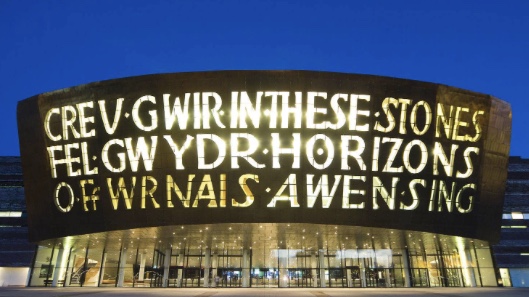Today’s lecture topic was the Eisteddfod, the annual poetry competition that technically dates back to 1172 (although in its current form it was invented largely by, yes, the Victorians). On the edge of campus there’s still a modern stone circle from the year that Cardiff hosted the Eisteddfod. A new stone circle used to be erected for each festival, until it got too expensive; now, the festival association has a set of plastic standing stones that they can easily erect and take down. As Professor Wood puts it in her plummy British accent: “The idea of moveable plastic megaliths is not something I can get my head around, thank you very much.”
And speaking of the performing arts, I must correct my earlier post about the Millennium Center. I assumed that the inscription was the same in Welsh and English. It’s not. Professor Wood’s rough translation of the Welsh bit is: “To create truth like glass from the furnace of inspiration.”

The fact that the inscriptions don’t match up does indicate interesting things about the Welsh attitude toward bilingualism. Welsh speakers can be militantly patriotic about their language; bilingual poets like Gwyneth Lewis sometimes write different material in English and Welsh and refuse to allow the Welsh to be translated. There’s a strong attitude—certainly understandable in the face of anxieties over language extinction—that if an English speaker wants to read Welsh literature, he or she should learn to speak Welsh.
And another Professor Wood-ism regarding the controversial modern architecture of the Millennium Center: “It’s supposed to represent the Welsh hills, but everyone calls it the armadillo.”